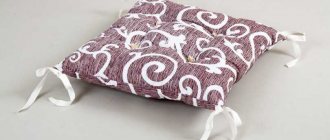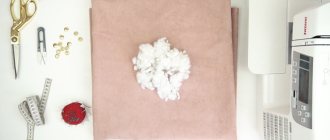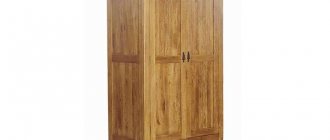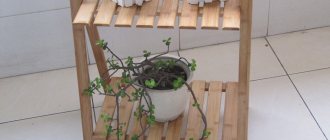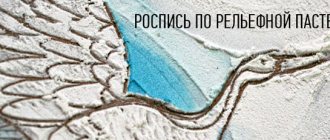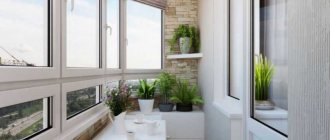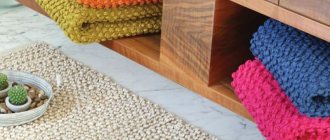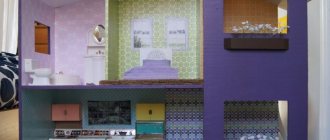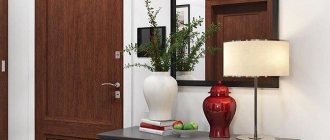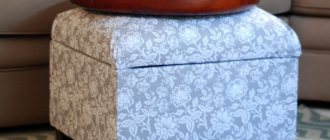It is difficult to find a person’s home that does not have at least one pillow. This bedding has long been used not only for its intended purpose, but also for interior decoration. Sofa cushions, made of decorative materials in the form of squares, triangles and bolsters, create a relaxed atmosphere, make the home cozy and relaxation comfortable.
Don’t despair if the store doesn’t have a pillow of the right color and size. This textile product can be made by hand. The main thing is to choose a high-quality filler and carefully, following the advice of professionals, carry out the work.
A little history
Initially, pillows were used by wealthy representatives of the ancient nobility in order to preserve the integrity of intricate hairstyles of complex shapes for several days.
The first devices were not intended for comfortable lying on the bed; they mainly served as a device for conveniently supporting the head during night sleep.
Representatives of eastern countries often used processed marble or porcelain for this. It was placed under the cervical vertebrae while lying down only to preserve the hairstyle. Representatives of the ancient nobility often spent time lying on soft mattresses and attached great importance to comfort.
Pillows, in the form that have survived to this day, were invented by the nobility of Ancient Greece. They were filled with aromatic herbs, down, and feathers. Thus, this attribute became mandatory even for warriors of the Roman army seasoned in military campaigns.
How to choose: useful tips
When purchasing a product for comfortable sleep, it is important to consider several factors:
- how a person is used to sleeping. A medium-firm base is suitable for anyone who rests on their back; for sleeping on their side, a fairly firm option is suitable. If your usual position is sleeping on your stomach, then you need a soft pillow;
- How hard is the mattress? The combination of a soft mattress and a high, dense pillow can lead to serious health problems and pinched nerves in the spine. The best option is to buy an orthopedic mattress and a base for the head, taking into account the main sleeping position. It is ideal if you purchase an orthopedic pillow that allows the cervical area to take an anatomically correct position;
- product height. On the “correct” pillow, the head lies freely, without obvious kinks in the cervical spine. A product that is too flat is contraindicated for hypertensive patients and people suffering from fluid reflux into the esophagus (reflux esophagitis);
- head base size. The best option is for the edges of the pillow to be at shoulder width. Sleeping on a small base is uncomfortable; a product that is too large interferes if a person turns over and sleeps on his side (the face “sinks” in a pillow that is too wide).
How to choose a dishwasher for your home? Read helpful tips from experts.
Read about the advantages and disadvantages of ceiling infrared heaters for apartments at this address.
Deciding on the choice of fabric
A solution worthy of respect among housewives is to make your own pillows for yourself and your family members. First you need to decide on the purpose, filling material, type of pillowcase fabric and geometric dimensions of the pillow.
The use of down and bird feathers involves the use of teak. This fabric is dense to the touch, quite durable and does not allow natural filler to pass through. For fillers of artificial origin, ordinary cotton fabric is suitable.
On specialized websites you can find a large number of photos of homemade pillows. In a relaxed atmosphere, you will be able to carefully examine and familiarize yourself in detail with the step-by-step instructions for making the selected pillow model.
What to choose?
When the question arises, which fabric will be better, you should focus on the purpose of purchase and the filling of the pillow. The insides of the product are divided into two types: natural and artificial. The owners rely on their own vision on what to choose. But the natural option is increasingly being left aside, especially when it comes to using such a pillow in public places (hotel, inn, motel).
To make this accessory comfortable and durable, there are several factors that are worth paying attention to.
The fabric must be durable, and at the same time soft, breathable and hygroscopic.
The reason for the preference for artificial substitutes is the absence of allergens inside them, even after time, mites and dust. Plus they are easier to wash and dry. And natural filling is usually chosen for the soul by those who want to be closer to nature, and their health allows it.
It is very important to select the appropriate material for sewing a bedspread.
The material should be both dense and soft.
We sew our own pillow
First, you should prepare everything you need: a piece of thick fabric of the appropriate size, the required amount of filler, special scissors, a ruler, a regular chalk or marker, threads of the appropriate color, a sewing machine.
In fact, sewing a pillow with your own hands is not at all difficult. Measure out two standard pillow size rectangles or use pillow patterns. Fold the right side inward and sew on three sides using a sewing machine. Sew the fourth side to about halfway, so that it is convenient to fill the inside of the pillow with filler.
Note!
Duvet: TOP-170 photos + video reviews of duvets. Advantages and disadvantages of filler, choice of cover and quiltingBed linen for newborns: requirements for bedding for a newborn. Variety of sizes, materials and patterns of children's underwear (photo + video)
- Double bed linen: TOP-170 photo reviews of new designs, choice of size, color and material
Turn the cover right side out and fill the inner volume of the pillow with the selected filling. Now you can carefully sew the remaining part by hand using an inconspicuous seam. Don’t hold back your imagination and decorate with national embroidery, appliqués or just braid.
Sewing cushion covers for the sofa
Sofa cushions have long been a favorite decor item, because it is so cool and convenient to have a large number of them. They are used every day, which negatively affects their appearance, so every housewife thinks about its safety.
A pillowcase is one of the easiest ways to protect yourself.
Pillowcase for square pillow 70×70
You don't need a lot of investment to create a pillowcase.
Necessary:
- material, preferably easily washable;
- large ruler, meter;
- soap or marker for a pattern;
- sewing machine;
- lock.
Let's move on to sewing.
Algorithm for making a simple square pillowcase:
- We make a rectangular pattern with a length of 144 cm and a width of 74 cm.
- Iron the fabric and fold it in half so that the right side is on the inside.
- Carefully sew the lock to the fabric, do not forget to retreat 2 centimeters, which are left for the allowance. We check it for functionality.
- We sew up the sides of the pillowcase, being careful that the fabric does not stretch or bend anywhere.
- Turn the cover right side out and put it on.
The pillowcase can be either a classic plain one or made using any technique, for example, patchwork.
The video provides an overview of sewing a pillowcase.
Pillowcase with “ears” for a rectangular pillow 50×70
A cover for a sofa bed does not have to be complex in design, since ordinary “ears” can make your product laconic and suitable for the decoration of the apartment.
Materials required for sewing:
- textile;
- meter;
- scissors;
- sewing machine.
To sew a cover for a 50×70 pillow, follow these steps:
- We cut out a rectangle measuring 190 by 63 centimeters.
- Fold the fabric on the short side, first 1 cm, and then another centimeter, and make a seam. This edge treatment will look neat on the outside of the pillowcase. We carry out the procedure on both short sides of the canvas.
- We measure 75 cm from one processed edge and fold the fabric, the front side should be inside.
- Then we count out another 5 centimeters, and fold the other side taking this distance into account.
- We make running seams or pin them.
- Place seams on the sides of the pillowcase.
- We turn out and iron the resulting workpiece.
- We measure 5 centimeters on each side to make “ears” for the cover.
- Mark the seam line with soap.
- We sew exactly along the intended line very carefully, since this is the front side.
The sewing algorithm is presented more clearly in the video.
Types of pillows by purpose
Pillows can be used for more than just sleeping comfort. Decorative pillows are very popular among adult housewives.
Sewing a decorative pillow with your own hands is not at all difficult. They not only provide comfort while sleeping, but also decorate the interior. They don't have to be soft and pleasant to sleep on.
Pillows are usually placed on soft corners, armchairs, chairs or benches. Pillow patterns can be studied in detail on specialized websites. Sintepon or feathers are usually used as filler for decorative pillows.
Pillowcases for decorative pillows can be decorated with a variety of appliques, embroidery of national ornaments, and original shapes. A special atmosphere in the room for children will be created by decorative pillows in the shape of funny animals or the main characters of children's cartoons.
Primary requirements
Everything is simple with the sofas themselves. Spring blocks, polyurethane foam filler and their combinations are used here. If you fill upholstered furniture with high-quality foam, it will last for ten years.
Requirements for pillows depend on the purpose for which they are intended. Therefore, different fillers are suitable for different purposes.
The filling of decorative pillows is less important. You can take almost anything here.
It is much more important to stuff a large pillow that will bear the load. That is, when a person sits, sleeps or rests on it, leaning his back or head.
The basic requirements for how to stuff a sofa pillow are as follows:
- Elasticity
. The product must maintain its proportions and not be deformed. When crumpled, return to its original shape; - Air permeability
. Air must pass through the accessory. Otherwise, it will be impossible to lie down, much less sleep; - No allergic reactions
. Relevant for some people; - Easy to care for
. Easy to wash and quick to dry. Ideally, the material can be thrown into the washing machine.
In fact, all fillers are divided into 2 large categories.
Arrangement of pillows in the interior of the room
Usually the location of the pillow determines its name. A handmade sofa cushion will look great not only on the sofa, but also in a chaise lounge, ottoman, or wicker chair.
Note!
- Pillow for pregnant women - TOP 160 photos + video reviews of pillow designs for pregnant women. Properties and purpose of the pillow. Types of fillers and covers
Sofa decks: TOP-130 photos and videos of sofa deck design options for a sofa and armchair. Features of application, choice of color and material of manufacture
- Envelope blanket - TOP 150 photos + video reviews of baby envelope blanket designs. Types of safe fabric materials, colors and prints of blankets
Sofa cushions can have a classic rectangular shape; they are usually called “dumkas”. Cylinder-shaped pillows are quite hard and densely filled with filler. They are used as armrests and headrests, very rarely for sleeping.
Such pillows are decorated with all kinds of folds and complex weaves of fabrics. The front part of the pillow can be finished with embroidered multi-colored beads or embroidered satin stitch patterns.
Sofa cushions in the shape of letters are gaining popularity among young housewives. The front part of such pillows can be made of shaggy material in combination with satin fabric, which will be in harmony in color.
What fabrics are suitable for decorative pillows?
A decorative pillow can be sewn from the same materials as the bedding. But it is better to opt for those options that will emphasize the unique style of the owners of the house:
- Fabrics for furniture upholstery
Pillows made of flock, chenille, corduroy, velor and other fleecy fabrics create an atmosphere of homely warmth. Such products can be additionally decorated with ribbons, buttons or appliqués.
- Fur
Fur pillows scattered on the sofa look cute and warm during the cold season. True, they need to be vacuumed regularly.
- Old clothes
A pillow made from leftover fabric from old clothes (jeans, knitted blouses and dresses, fleece) looks unusual. You can experiment with colors, sizes, shapes and create a product that you won’t find in any store.
Choosing the right fabric
A pillowcase can be called the main part of the front part of a sleeping pillow. When sewing pillows on their own, thrifty housewives often use old clothes from the closet: blankets, T-shirts, shirts.
Synthetic fabrics are offered in large quantities in the specialized materials trading network. The most popular fabrics for homemade sewing of pillow covers are: teak, satin, percale, cambric, twill.
Note!
- Children's blanket: criteria for choosing a blanket for children. A variety of sizes, materials and patterns of children's blankets. Rules for caring for a child’s blanket (photo + video)
- Bedspread for a sofa: TOP-140 photos and videos of design options for a bedspread for a sofa. Features of the use of the bedspread, choice of color and material
Wool blanket: options for using wool blankets. Advantages and disadvantages of wool, varieties of sizes and shapes of blankets (photo + video)
The rule of good manners among modern young housewives is to make a pillow with your own hands for family members from natural fabrics. To do this, you should pay attention to fabrics such as:
Linen. The material is pleasant to the skin, despite the roughness of the texture. Gives a feeling of warmth and comfort in winter, and ensures comfortable sleep in the hot summer. This fabric wrinkles easily and quickly.
Silk. The material is quite delicate to handle. Pillows with silk pillowcases will find their rightful place on a luxurious sofa with classic interior design.
Cotton. This is a universal material in terms of price-quality combination. Cotton pillows can easily be stylistically integrated into any design project.
Wool. At first glance, wool pillows look rough and clumsy. They create an unforgettable feeling of home comfort in the cold winter. It is worth paying attention to the correct choice of pillow filling for a pillowcase made of natural wool.
Options
The most popular fabric options.
- Satin.
A type of cotton product, it has quite high strength, and it is attractive in appearance, as it gives off a glossy appearance.
Satin is a cotton fabric made by weaving twisted threads.
- Batiste.
It is light, soft, but prone to rubbing.
Batiste is a light and transparent fabric.
- Jacquard.
This is not a simple weaving of different types of fibers; it has strength, elasticity, breathability and aesthetics.
It is dense, elastic, and allows air to circulate well.
- Percale.
It is relatively hard-wearing, breathable, and tends to retain heat.
High-strength cotton fabric made from untwisted threads.
- Flannel.
It retains heat, but quickly loses its former appearance due to the appearance of pellets. The owners are happy with it: comfortable, soft, pleasant.
Flannel is a cotton, wool or wool blend fabric of plain or twill weave.
- Bamboo.
It is natural, has a glossy surface, and is believed to have an antibacterial effect on the environment.
Bamboo is a natural material, similar in quality to silk.
- Linen.
It is thin, durable and wear-resistant, usually woven together with cotton.
Linen is the oldest fabric; it used to be difficult to obtain, but now it is easily available.
- Tick or tick-inlet.
Chinese material, gaining popularity in the world, it is dense and soft, but it is important to choose the right one.
Teak is a dense natural fabric intended primarily for sewing mattress covers, bedspreads, covers, and awnings.
Sometimes wool is also selected (preferably with an admixture of delicate fibers, so as not to sting) to relieve unhealthy conditions, such as headaches or joint problems.
Pillow filler
An important question that arises when making your own pillow is what to use as a filler?
Natural fillers require special care, these include: swan down, horse hair, sheep or camel wool, buckwheat husk. Such fillers have a fairly high price and are used by pillow owners directly for night sleep.
The leading place among synthetic materials for stuffing is occupied by padding polyester. This material does not cause an allergic reaction in the user, has a low specific gravity and a fibrous structure that allows air to easily circulate inside the pillow.
The next modern material is holofiber. It is also actively used by manufacturers as a filling for pillows. With a low specific gravity, the material allows air and moisture to pass through quite well.
About comfort, as a separate type of filler, we can say that these are synthetic balls with a diameter of up to five millimeters. A pillow filled with such a filler almost immediately restores its lost shape after dynamic effort.
So go for it! Create new things, create hand-made masterpieces with love for your family members in the form of pillows for sleeping and relaxing.
Synthetic
Now to the question of what to fill a sofa pillow with among the synthetic filling options.
A number of synthetic products work no worse than their natural counterparts. And in some places they are superior.
The main advantages are:
- Dangerous dust mites do not appear
. Over time, no microorganisms will appear inside. This is a godsend for people with allergies; - Easy to care for
. Synthetics can be safely thrown into the washing machine and dried. Dries quickly. They don't lose their shape.
At the same time, there are several options for stuffing a sofa pillow.
- Sintepon
. Many people stuff it with padding polyester. Budget-friendly but short-lived material. It is soft and also porous. It will quickly cake and lose shape. Lumps appear. Suitable as stuffing for a decorative pillow. If you plan to sleep, sit or lie on it, then refuse this option; - Holofiber
. Holofiber stuffing is more preferable. This is a non-woven material made from polyester-based fibers. Excellent air permeability and effective moisture removal. Does not accumulate electricity and does not absorb foreign odors. Serves for more than 5 years. Machine washable and dryable; - Yarn and fur
. Only of artificial origin. Excellent stuffing option. But it is better to fill the pillow with good foam rubber on both sides of the filler.
Then the choice is yours.
DIY pillow photo
Carrying out work step by step
If you have stocked up on all the necessary materials and tools, you can start making the pillow. The algorithm for performing the work is as follows.
- Making a paper pattern. The dimensions and shape of the patterns depend on your preferences and the chosen model. Alternatively, you can take ready-made parameters from the Internet, or use someone else’s experience (pattern).
- Transferring the finished pattern onto the fabric. To avoid displacement, it is better to pin paper patterns to the fabric with tailor's pins. The pinned patterns are traced along the contour with a sharpened soap or cutting chalk.
- Reveal the details. The parts are cut out taking into account seam allowances (for stitching). The size of the allowance is 1-1.5 cm.
- Basting and stitching pillow parts. Pieces folded face to face are basted or pinned with tailor's pins (to avoid displacement during the stitching process). Sew down the parts, leaving the hole for inserting the filler free, and turn the napkin inside out onto your face.
- Filling. The pillow is slowly filled with filler, distributing it evenly. As mentioned above, the hole for inserting the filler should not be filled in immediately. It is better to “grab” it manually using running stitches (or sew in a zipper) and test the product for several days or nights. You may need to increase or decrease the amount of padding to achieve optimal comfort.
